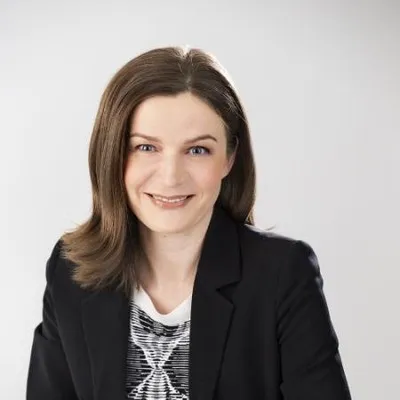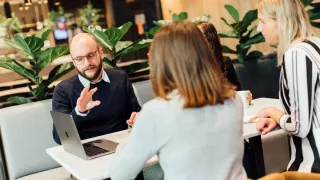VTT develops sustainable solutions with customers and partners to solve global problems. Doing so requires absolute and ambitious sustainability in our own activities, which we want to constantly improve. The goalpost of sustainability will never stop moving, so every step forward is cause for celebration.
VTT published its first sustainability programme at the turn of the year 2021–2022. To create the programme, VTT conducted stakeholder interviews and materiality analysis and selected four sustainability priorities:
- sustainable foundation
- thriving professionals
- empowered customers
- resilient society.
During this past year, systematic and determined sustainability work has started to take shape, and things have progressed in different parts of the organisation.

We always drive sustainable business
In the VTT Executive Leadership Team, corporate sustainability is the responsibility of Jussi Manninen, Executive Vice President of Carbon Neutral Solutions, while Tiina-Liisa Forsell, Vice President of Operational Excellence, is in charge of sustainability work in practice.
“Sustainability is an important part of our strategy”, Manninen emphasises, “and one of our five strategic choices is to always drive sustainable business. In order to build sustainable growth for customers and society, our own sustainability work must be systematic and ambitious.”
VTT is committed to the UN Global Compact corporate sustainability initiative and participated in the Early Adopter programme at the beginning of the year, where we piloted a new reporting platform that will be available to all members next year. “We follow GRI when reporting on our sustainability in our annual report”, says Tiina-Liisa Forsell.
EU’s new Corporate Sustainability Reporting Directive (CSRD) will naturally also affect VTT which is categorised as a large company. “Preparations for the big shift have already started”, Forsell says. “The new double materiality analysis creates a foundation for sustainability work, and we have conducted related stakeholder interviews this autumn. We have also looked into solutions for managing sustainability data”, she continues. Year 2025 is the starting point for reporting in line with the new directive, but to get comparison data, VTT aims to comply with the new reporting requirements already in 2024.
Ethical principles guide all activities
One of our sustainability priorities is the sustainable foundation of our operations, meaning that we always act ethically and independently. All stakeholders must be able to trust that VTT will act ethically in every way in addition to complying with laws and regulations. Our operations are based on science and research. Each VTTer commits to the ethical principles of impartiality, reliability, integrity and responsibility. They are framed by our code of conduct, which should be fresh in everyone’s minds after an online course on the updated version early this year.
“In October, we announced an online course on research ethics. It is important that each of us is familiar with the ethics of research and what it all means”, Jussi Manninen underlines. “We have also piloted a combined research ethics and safety workshop in one business area”, he continues.
Having responsible supply chains is one of VTT’s greatest sustainability challenges. As a solution, VTT has been developing a tool to integrate sustainability aspects into competitive tendering processes more systematically.
Valuing our experts as they are
Everyone who commits to VTT’s values – respect, together, passion, forerunner – is welcome at VTT just the way they are. Diversity, equity and inclusion (DEI) are a prerequisite for a thriving work community and an especial asset in innovation work: to make technology accessible to all kinds of people, we need all kinds developing it.
Peppi Härme, HR manager responsible for DEI, explains the measures driving this theme: “All teams can order an inclusivity workshop led by an external expert. About ten teams have already taken up the offer, and the option will still be there next spring. In addition, we have established an internal DEI network and offer all VTTers an opportunity for emotional skills coaching.”
Impact is generated by customer success
“VTT’s impact is generated when technology and innovations are applied in practice in our customers’ everyday business”, says Jussi Manninen, describing the significance of RDI. For this reason, we want to select customers and partners in a sustainable way by carefully checking their backgrounds and goals: we have developed a Know Your Customer (KYC) review that is now an integral part of our sales process.
Tiina-Liisa Forsell reminds that research at VTT always happens in projects. For example in 2021, VTT had a total of 1,160 customers and 3,422 ongoing projects with them during that year. Customers’ views of VTT’s sustainability are surveyed annually with the customer impact survey.
Towards a sustainable society
VTT’s task is to solve global challenges through research, cooperation and innovations. The UN Sustainable Development Goals (SDGs) are a global description of issues that need to be resolved to give everyone the opportunity to enjoy a good life. VTT’s research activities are well-suited to support the promotion of the goals, and we have identified five SDGs that are most impacted by VTT’s research.
We have integrated the SDGs into self-funded and jointly-funded projects as well as our research information portal. “We are constantly getting more accurate data on how our projects affect the SDGs”, Forsell says. The aim is to carry out research that solves the right problems in a sustainable way.
One sustainability step after another
As our sustainability work progresses, the next targets start to take shape. The main goal has already been decided: “An important part of the sustainable foundation of our operations is the smallest possible carbon footprint and, on the flip side, the largest possible handprint, meaning the positive impacts of our operations”, Jussi Manninen points out. “Our goal is to be carbon negative by 2030.”
Achieving carbon neutrality consists of several measures. Tiina-Liisa Forsell shares one example: During 2023, VTT will invest in more detailed data collection on how VTT uses energy. The data is used to take measures to conserve energy and improve energy efficiency.
Starting 2023, customers’ view of VTT’s sustainability will also be included in VTT’s key performance indicators (KPIs). “The indicator answers the question of how many of our customers think that project cooperation with us promoted sustainability in their operations”, Forsell says. Next year we will also be able to link our commercial projects to the SDGs.
“Sustainability work is never finished. Even being able to set realistic but ambitious sustainability goals requires baseline data and broad insight”, Tiina-Liisa Forsell explains. “Fortunately we have a lot of expertise on the topic at VTT – and a shared will to make our own operations even more sustainable.”
Read more about our sustainability work





